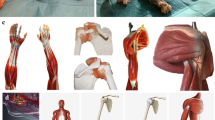Abstract
Background
Anatomic body painting (ABP) is a teaching tool utilized in many countries but not well known in the USA. Minimal research exists on ABP’s efficacy as a teaching tool. The high cost of anatomy labs, limited cadaver availability, and short timeline of physician assistant (PA) curricula make ABP an attractive resource for PA programs. Elon University has used ABP as an adjunct teaching tool in its PA anatomy curriculum since matriculation of its first class in 2013.
Purpose
This paper describes how and why ABP was incorporated into Elon’s PA anatomy curriculum, details adaptations made for incorporation into an American anatomy curriculum and offers an assessment of student acceptability of ABP as a teaching method at a US Physician Assistant program.
Methods
Literature search was performed assessing use of ABP at other programs. A survey comparing student perceptions of ABP to cadaveric dissection was completed by participants in two (n = 29; n = 32) ABP sessions.
Results
Key features of Elon’s ABP method and rationale for their inclusion are described. Cost for starting Elon’s ABP program was approximately $421.00. Student perceptions of ABP compared favorably to cadaveric dissection in perceived effectiveness, acceptance, and usefulness in understanding clinical correlations. Data suggest that ABP may make participants less uncomfortable physically and/or psychologically than cadaveric dissection.
Conclusion
ABP is an affordable adjunct to anatomy instruction that is well accepted by students and assists in understanding clinical concepts/correlations. The study is limited by small size and inclusion of one study center; further study is warranted.



Similar content being viewed by others
References
Op Den Akker JW, Bohnen A, Oudegeest WJ, Hillen B. Giving color to a new curriculum: bodypaint as a tool in medical education. Clin Anat. 2002;15:356–62.
McMenamin PG. Body painting as a tool in clinical anatomy teaching. Anat Sci Ed. 2008;1:139–44. https://doi.org/10.1002/ase.32.
Finn GM, McLachlan JC. A qualitative study of student responses to body painting. Anat Sci Ed. 2010;3:33–8. https://doi.org/10.1002/ase.119.
Finn G, White P, Abdelbagi I. The impact of color and role on retention of knowledge: a body-painting study within undergraduate medicine. Anat Sci Educ. 2011;4:311–7.
The American Association of Physician Assistants. https://www.aapa.org/about/history/, accessed 22 October 2017.
19th Annual Report on Physician Assistant Educational Programs in the United States. http://paeaonline.org/wp-content/uploads/2016/10/19th-Annual-Report-on-Physician-Assistant-Educational-Programs-in-the-United-States-2002-2003.pdf#page=74, accessed 22 October 2017.
PAEA Research Program 32 By the Numbers: Data from the 2016 Program Survey. http://paeaonline.org/wp-content/uploads/2017/10/ProgramReport32_2017_2.pdf , accessed 22 October 2017.
Accreditation Review Commission on Education for the Physician Assistant Accreditation, Standards for Physician Assistant Education, Fourth Edition. 2016. http://www.arc-pa.org/wp-content/uploads/2016/10/Standards-4th-Ed-March-2016.pdf, accessed 31 August 2017.
Hegmann T. Snapshot of anatomy teaching in physician assistant education. J Physician Assist Educ. 2013;24(4):19–21.
McLachlan J, Patten D. Anatomy teaching today: ghosts of the past, present and future. Med Educ. 2006;40:243–53.
Ali L, Nisar S, Ghassan A, Khan SA. Impact of clinical skill lab on students’ learning in preclinical years. J Ayub Med Coll Abbottabad. 2011;23(4):114–7.
Clough RW, Lehr RP. Testing knowledge of human gross anatomy in medical school: an applied contextual-learning theory method. Clin Anat. 1996;9(4):263–8.
Keim-Janssen SA, VanderMeulen SP, Shostrom VK, and Lomneth CS. Enhancement of anatomical learning and developing clinical competence of first-year medical and allied health profession students. Anat Sci Educ 2014;7(3):181–190. doi: https://doi.org/10.1002/ase.1398. Epub 2013 Sep 3.
Young J, Van Merrienboer J, Durning S, Ten Cate O. Cognitive Load Theory: implications for medical education: AMEE Guide No. 86. Med Teach. 2014;36(5):371–84. https://doi.org/10.3109/0142159X.2014.889290.
Ten Cate O, Kusurkar R, Williams J. How self-determination theory can assist our understanding of the teaching and learning processes in medical education. AMEE Guide No. 59. Med Teach. 2011;33(12):961–73. https://doi.org/10.3109/0142159X.2011.595435.
Kharb P, Samanta P, Jindal M, and Singh V. Learning styles and the preferred teaching—learning strategies of first year medical students. J Clin Diagn Res 2013 Jun; 7(6): 1089–1092.
Finn GM. Twelve tips for running a successful body painting teaching session. Med Teach. 2010;32(11):887–90. https://doi.org/10.3109/0142159X.2010.507708.
Gambino M. Should We Use Body Painting to Teach Anatomy? In Smithsonian Magazine; https://www.smithsonianmag.com/science-nature/should-we-use-body-painting-to-teach-anatomy-180947826 , published 25 November 2013, accessed 25 July 2014.
Funding
The musculoskeletal body painting session described herein was funded by a grant from Elon University’s Center for the Advancement of Teaching and Learning.
Author information
Authors and Affiliations
Corresponding author
Ethics declarations
Elon University Institutional Review Board approved this study of students participating in ABP as part of the didactic year anatomy curriculum (IRB Protocol No. 14-108). Informed consent was obtained from study participants by a faculty member not involved with the study.
ᅟ
Conflict of Interest
The author declares that there is no conflict of interest.
Additional information
Portions of this data were previously presented as a research brief at the 2014 Physician Assistant Education Association (PAEA) Forum (Philadelphia, PA), and as a poster presentation at the 2016 American Association of Anatomists (AAA) Regional Meeting, New York, NY.
Rights and permissions
About this article
Cite this article
Bennett, C.C. Anatomic Body Painting as a Teaching Tool in Physician Assistant Education. Med.Sci.Educ. 28, 525–532 (2018). https://doi.org/10.1007/s40670-018-0581-y
Published:
Issue Date:
DOI: https://doi.org/10.1007/s40670-018-0581-y




